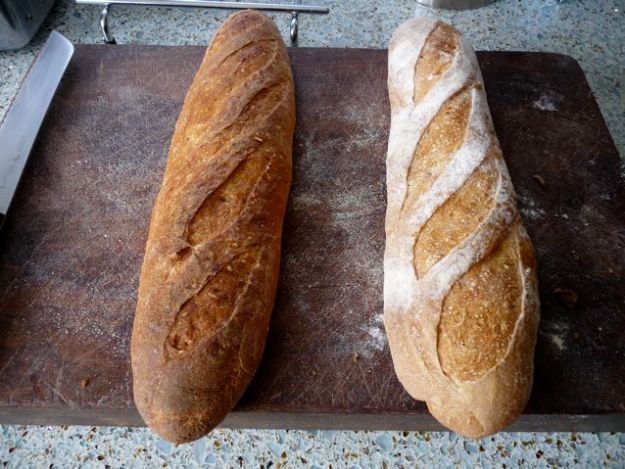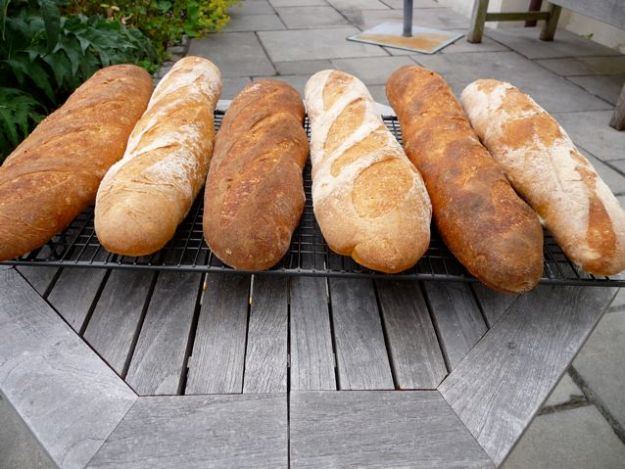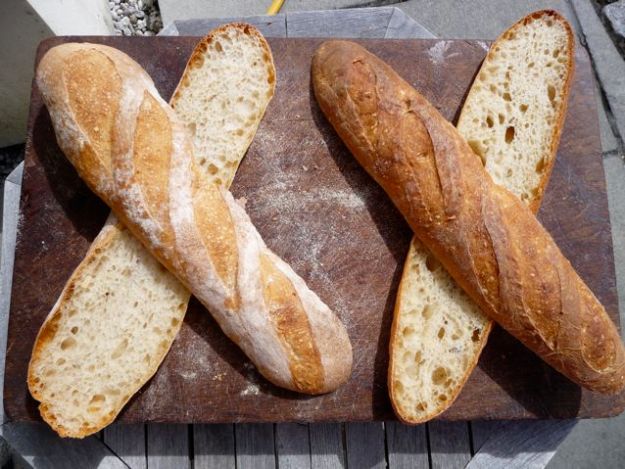This is for anyone who wants to read more about the French Bread from yesterday’s post.
July’s breads for Mellow Bakers: French Bread, Bialys and a 70 % rye sourdough – all from Bread by Jeffrey Hamelman.
I thought I’d start with this one. If you want to see what other Mellow Bakers made of this, click here. Or visit their blogs, some of which are listed in the side bar. And if you want to join in we’re very nice and friendly, jump in at any time, and bake any of the breads you fancy and either post on your blog or post something about it on the Mellow Bakers site. If you need cheering up, you can always visit the bread disaster thread too :)
Jeffrey Hamelman’s French Bread is a dough made with 70 % water to 100% flour, 2% salt and a little yeast: so quite a loose dough but not wildly wet like a ciabatta. It’s what is called a straight dough. No poolish, no pre-ferment, nothing. So this was a good opportunity to review a basic bread dough and practise the dreaded shaping. If you want to have a go at these, just follow a basic dough recipe, watch the shaping video, heat your oven up really hot, dig out a good sharp knife to do the slashes with and give it a go. If you make the dough with a little less water, say 65 % water to 100 % flour you will find the dough easier to shape.
I use less yeast than in the book, 1/2 tsp per 450 grams of flour, because while it has been so hot lately the bread has been rising super quick and I wanted to keep to a longer rise in order to give the flour a chance to ferment a bit and develop some flavour.
How to make it a bit more interesting while following the recipe?
I decided to make two half batches of this dough using two different flours and try to keep the rest of the process the same. This was my attempt at being scientific and methodical, not something that comes particularly naturally to me.
I made one lot with Waitrose Organic Strong White flour, my usual bread flour and the other lot with organic 00 Italian flour. In theory, the 00 should give you a thinner and crisper crust. or so I have read, plus it is lower in protein and feels finer so the bread should be different….
I mixed both lots of dough in a stand mixer for the same periods of time. There was a time lag of about 10 minutes as I mixed one lot straight after the other.
Bulk prove of 3 hours, with two folds. At the end of that time, I shaped the dough into rounds, went upstairs and watched the baguette shaping video by Ciril Hitz on Mellow Bakers again….
think I got the idea…..came downstairs and had a go. The point of the pre-shaping is made clear in the video and every time I skip doing it, I regret it. This time I did my best to play along though.
I reckon I need to do a few more thousand before I can look as cool as Mr Hitz! The chief disaster point seems to be the level of tackiness needed for successful shaping, too much flour sprinkled on the worktop and the dough gets little wrinkles in it and rolls around, too little and it sticks and you lose your shape and the careful tightening of the surface goes to hell in a handbasket…
I remember reading Susan at Wild Yeast writing about making baguettes solidly for two weeks at SFBI, that’s the answer I guess if baguettes are what your heart desires :) There is a huge gulf between having fun at home and turning out commercial baguettes, I’m still at the having fun stage :)
What happened next?
Constrained like a lot of home bakers by the size of the oven, I divided each lot of dough into three portions, giving me approx 250 grams each and aimed for a length of about 14 inches on the baguettes. You could call them mini bags.
So I did my best impersonation of Ciril Hitz, got a bit better by the time I got to the last one, isn’t that always the way? Then I put them in a couche cloth for a final prove of an hour and a half. I noticed that Ciril’s way gave me better, more rounded ends, not the little nose drip ends I often create.
Heated oven up with the kiln shelf in up to 240 C on top bottom heat. Little iron tray on shelf below for the boiling water to go in to create a bit of steam.
All going reasonably well, baguettes rising nicely, actually they don’t look too bad at this point….
…popped them in the oven anyway and baked them super hot with steam for about 22 minutes. Those are the darker ones made with the regular flour. I liked the colour of these ones best.
Then into the oven with the second lot the oven was a bit cooler, maybe 10 degrees or so – they came out a little paler, was this due to the flour type, the bit of protective flour on the top, who knows? I take my hat off to any one who can really only change one variable and leave everything else exactly the same when they are home baking, I sure can’t manage it.
Anyway here they are – I liked the darker crusted ones colour wise, however the paler ones made with the 00 tasted a little sweeter and wheatier. What’ s interesting is how similar their insides look, not a whole lot of difference there in the look and texture of the crumb.






Wow! You really took this one on with a vengeance! Well done. Beautiful loaves, and very informative post!
I just read something that Nils, the inverse cook at Ye Old Breade Blogge, has written about brushing water over the slashes two or three times in the first ten minutes of baking and if you see the results I think he is on to something ! http://tweetphoto.com/31645952
Joanna, those baguettes looks great. Your scoring is also very well done.
What an interesting comparison. They all look wonderful to me. I’m in awe of your baking skills Jo.
I have edited out the swearing when the blade catches in the dough and tried to stay positive and serene (at least in this post), so I’ve managed to fool some of you at least. I wish I had a huge oven so I could make big full size baguettes – I sometimes wonder if that is what’s missing. I didn’t get ears this time, the tops of the dough simply wasn’t taut enough to open up properly. It’s very exciting when you do get ears though! Maybe next time …..
Jo, you’re a star. I wish I’d read this post and watched the video before I made baguettes yesterday. But I got so excited by your photos that I had to rush straight out and make some spelt ones. They tasted wonderful, but didn’t look nearly as pretty as your or Chef Hitz. They were scoffed at dinner with much enthusiasm, and the boys had the last one for lunch today, stuffed with Italian prosciutto. I can see how Susan spent two weeks making baggies – I always forget how much we like eating them.
One question – your couche cloth – I always use teatowels and end up with rye flour everywhere. Do you have to dust the cloth every time? Also, you’re trying to make rounded ends, and I’m trying to make pointy ones! :)
There are loads of ways to do baguettes, but this is a nice clear video isn’t it? Look forward to seeing some pics of your spelt babies, Celia!
If you use a heavy duty linen ‘couche’ cloth (couche = sleep) then you don’t need a whole lot of flour on it, cotton teatowels are more sticky, because cotton has shorter, fluffier fibres as opposed to the long smooth fibres of linen or flax. Having said that I had to wash my cloth the other day and had a bit of a tussle getting it smooth and flat again, linen has to be not too wet and too dry in order to press it.. so it’s six of one and half a dozen of the other. If you have linen tea towels they will work better than cotton and need less flouring. Here’s a thread started by Jacqueline in Australia on Dan’s forum on the subject.
Round ends, pointy ends all good :) I just don’t like the ones with the little bit sticking out, in fact Ciril Hitz had one of those in his film, so even he isn’t perfect!
I think all of your baguettes look great, but I agree that I prefer darker crust. Maybe I should play around with flours too–I always have a hard time getting dark crust on French bread. Hoping I’ll have time this month to try this recipe, but not sure when yet.
It might be your oven that doesn’t get hot enough Di. I am always torn between the cost of the electricity to get it super hot and my desire for dark crusts!
Edited comment to say:
The other thing to try, especially if the dough is having a long prove, is to give the yeast some extra sugar in some form, spraymalt powder (the stuff they use for beer is good for that and comes in pale as well as dark varieties), then I think the theory goes, if the yeast doesn’t eat all the available sugar, there is some left to do the Maillard reaction thingy and give you that nice ruddy brown colour on your crust .
Now, the bit I liked about this was “I’m still at the having fun stage” – does this mean you might be thinking of going commercial?
Choclette, I think I was just commenting on the gulf between the commercial baker whose wares have to look spot on every time and the home baker who can be as quirky and imperfect as they please and shouldn’t get too worked up if they can’t reproduce a commercial bread exactly .. I wold love to be involved in a community baking project in some capacity, not sure what though. Pipedreams :)
Really interesting and so impressive. I just love how easy the professionals make it look though…I can imagine me swearing a lot trying to replicate these..
Annalisa, you wrote about using a big heavy knife to score with here on your lovely blog, well I did just that with the second lot and the cuts opened better and it felt a lot easier, but I couldn’t put them where I wanted to properly. Sigh. So these ended up looking a bit raggedy and yes there was lots of swearing and no nice background music :)
Oh, what beautiful loaves, Joanna! I’m in awe. I attempted some baguettes recently, proving them in a flour lined tea-towel (my first attempt), but was ever so frustrated in getting them from the cloth to the oven without ruining them! Thanks for going into such detail in your bread making adventures :-)
No awe please :) What you need is a ‘flipping board’ Here is a picture of one sold by Bakery Bits, who I realise are a long way away, so if you are good at wood work, or can find something to substitute for one of these that is the answer to getting the long soggy ones from cloth to tray. Here also is link to very good video from Susan at WIld Yeast who is a brilliant baker. As she says ‘a narrow piece of stiff cardboard will do the trick’ Learnt a lot from her site :) She makes awesome baguettes !
Aaaah, yes, that is exactly what is needed, thankyou!! Wow, watching the video, she makes it look so easy! Thanks again, I think I will get cracking with some improvising of wood….:)
Found you by way of Celia’s blog, fabulous bread and tutorial, and something for me to do when I am craving French baguettes which is almost always, Roz
Thanks Roz. I visited your blog last night, what a beautiful house you have. I wish I was younger and could emigrate… :)
Pingback: Heat Wave Thoughts | Zeb Bakes